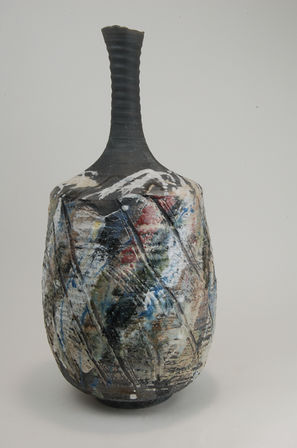Steven Branfman
The Potters Shop & School
Location
9
31 Thorpe Road
Gorse Mill Studios #L-101, L-109
781-449-7687
Medium:
Ceramics
Steven Branfman Residence:
43 Chinian Path, Newton Center MA 02459 USA
617-964-0442
Art has always been a part of my life. My mother was a graduate of The Julliard School studying piano, bassoon, and spent some time drawing. Her grandfather, a Russian immigrant who lived with us when I was a child, was a tailor and maker of fine clothing. My Great Uncle, also from Russia and with whom I was very close, painted landscapes while he made his living as a house painter. My uncle was a talented painter and musician. My parents saw the value in art and took my siblings and me to museums, concerts, Broadway plays, and to our chagrin forced us to take music lessons.
Clay entered my life as a random encounter in 1971. John Jessiman, my teacher, mesmerized me with his fluidity and ease with clay. After seeing him throw I decided I wanted to be a potter. At Rhode Island School Of Design, Norm Schulman was unforgiving, rigid, and set in his ways. I learned a lot from Norm and the whole scene there. The year spent at RISD was the most influential experience in my decision to work with clay.
Technique
From my earliest introduction to clay I have always been fascinated and excited about the wheel; the speed, fluidity, and in particular, the sense of growth I observe and control during the process. My work is about vessels and the characteristics that make the vessel come alive: volume, texture, color, and scale. The Raku process, method, and culture envelopes me and fuels my creative language. It is deeply rooted in tradition. And while I approach it with the utmost respect for its origins, its contemporary incarnation is very different. I can work simultaneously in a traditional method where all the rules have been established, and a contemporary technique where the rules are constantly in question. Raku firing is fast by its design and spontaneous by my nature. There is a lot of chaotic appearing activity for a very short time requiring exacting cooperation between myself, my equipment, my assistants, and the fire, and the success of the work depends on my ability to command and predict the variables of material and fire.
Motivations and Inspirations
My work comes from a tradition of functional vessels. When I began my education I was drawn to the concept of pottery being both utilitarian AND sculptural/decorative and I made purely functional pots; bowls, plates, cups, teapots, pitchers, etc. As my work and career matured I drifted from functional work and concentrated on decorative pots though always maintaining my commitment to the functional object and the vessel form. I am motivated by the need to express myself and communicate through my work. Clay is a language as sure as any spoken or written word. I speak the language of clay and Raku is my dialect. Vessels have a volume and an inward pressure that defines the shape. Pots are formed from the inside out and the bottom up with the interior negative space defining the outward appearance. I see the surface of my pots as a skin that defines and communicates the volume and presence of what is underneath. My surfaces define the shape with textures that expand and grow during the forming process.
I am influenced by the visual quality of the landscape, rock faces, cracks in the sidewalk, tree bark, colors of the earth and sand, moss, river beds, waterfalls, sunsets, the undulating path of a mountain range. I am influenced by the tactile nature of the air and natural and man-made surfaces. I am influenced by the smells and tastes of the cuisine that we welcome. I am inspired by the connection that my son and I had through our common bond of this earth bound, plastic, expressive material that is so often underfoot and that so many people take for granted. I am inspired by the ability to speak through the language of clay that Jared and I naturally and fluently shared with each other. An artist’s work must create a dialogue and speak to the viewer. An artist’s work must be honest and must come from within the artist. There is no art without emotion, without dedication, without passion. My most successful work is that which I feel the most intimate with from the initial idea to the completion of the piece.
Click on the featured artwork image for more info on the artwork.







